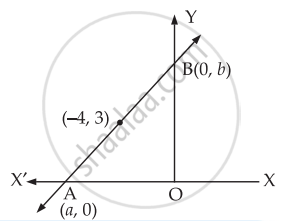Advertisements
Advertisements
प्रश्न
Find the equation of the line which passes through the point (– 4, 3) and the portion of the line intercepted between the axes is divided internally in the ratio 5 : 3 by this point.
उत्तर
Let AB be a line passing through a point (– 4, 3) and meets x-axis at A(a, 0) and y-axis at B(0, b).
∴ – 4 = `(5 xx 0 + 3a)/(5 + 3)`
⇒ – 4 = `(3a)/8` .....`[(because "X" = (m_1x_2 + m_2x_1)/(m_1 + m_2)),("and" "Y" = (m_1y_2 + m_2y_1)/(m_1 + m_2))]`
⇒ 3a = – 32
∴ a = `(-32)/3`
And 3 = `(5.b + 3.0)/(5 + 3)`
⇒ 3 = `(5.b)/8`
⇒ 5b = 24
⇒ b = `24/5`
Intercept form of the line is
`x/((-32)/3) + y/(24/5)` = 1
⇒ `(-3x)/32 + (5y)/24` = 1
⇒ – 9x + 20y = 96
⇒ 9x – 20y + 96 = 0
Hence, the required equation is 9x – 20y + 96 = 0.
APPEARS IN
संबंधित प्रश्न
Find the coordinates of the foot of perpendicular from the point (–1, 3) to the line 3x – 4y – 16 = 0.
Find the equations of the sides of the triangles the coordinates of whose angular point is respectively (1, 4), (2, −3) and (−1, −2).
Find the equation of the side BC of the triangle ABC whose vertices are (−1, −2), (0, 1) and (2, 0) respectively. Also, find the equation of the median through (−1, −2).
Find the equation of a line for p = 4, α = 150°.
Find the equation of a line for p = 8, α = 225°.
The length of the perpendicular from the origin to a line is 7 and the line makes an angle of 150° with the positive direction of Y-axis. Find the equation of the line.
Find the value of θ and p, if the equation x cos θ + y sin θ = p is the normal form of the line \[\sqrt{3}x + y + 2 = 0\].
Find the equation of the straight line which makes a triangle of area \[96\sqrt{3}\] with the axes and perpendicular from the origin to it makes an angle of 30° with Y-axis.
Show that the origin is equidistant from the lines 4x + 3y + 10 = 0; 5x − 12y + 26 = 0 and 7x + 24y = 50.
Find the point of intersection of the following pairs of lines:
2x − y + 3 = 0 and x + y − 5 = 0
Find the point of intersection of the following pairs of lines:
\[y = m_1 x + \frac{a}{m_1} \text { and }y = m_2 x + \frac{a}{m_2} .\]
Prove that the lines \[y = \sqrt{3}x + 1, y = 4 \text { and } y = - \sqrt{3}x + 2\] form an equilateral triangle.
Find the coordinates of the incentre and centroid of the triangle whose sides have the equations 3x− 4y = 0, 12y + 5x = 0 and y − 15 = 0.
Prove that the following sets of three lines are concurrent:
15x − 18y + 1 = 0, 12x + 10y − 3 = 0 and 6x + 66y − 11 = 0
Prove that the following sets of three lines are concurrent:
3x − 5y − 11 = 0, 5x + 3y − 7 = 0 and x + 2y = 0
Prove that the following sets of three lines are concurrent:
\[\frac{x}{a} + \frac{y}{b} = 1, \frac{x}{b} + \frac{y}{a} = 1\text { and } y = x .\]
Find the conditions that the straight lines y = m1 x + c1, y = m2 x + c2 and y = m3 x + c3 may meet in a point.
If the lines p1 x + q1 y = 1, p2 x + q2 y = 1 and p3 x + q3 y = 1 be concurrent, show that the points (p1, q1), (p2, q2) and (p3, q3) are collinear.
Find the equation of the straight line which has y-intercept equal to \[\frac{4}{3}\] and is perpendicular to 3x − 4y + 11 = 0.
Write the area of the figure formed by the lines a |x| + b |y| + c = 0.
The point which divides the join of (1, 2) and (3, 4) externally in the ratio 1 : 1
If the lines x + q = 0, y − 2 = 0 and 3x + 2y + 5 = 0 are concurrent, then the value of q will be
Find the equation of the line where length of the perpendicular segment from the origin to the line is 4 and the inclination of the perpendicular segment with the positive direction of x-axis is 30°.
Find the equation of the straight line which passes through the point (1, – 2) and cuts off equal intercepts from axes.
A line cutting off intercept – 3 from the y-axis and the tangent at angle to the x-axis is `3/5`, its equation is ______.
A line passes through (2, 2) and is perpendicular to the line 3x + y = 3. Its y-intercept is ______.
Reduce the following equation into slope-intercept form and find their slopes and the y-intercepts.
6x + 3y – 5 = 0
Reduce the following equation into normal form. Find their perpendicular distances from the origin and angle between perpendicular and the positive x-axis.
y − 2 = 0
Reduce the following equation into normal form. Find their perpendicular distances from the origin and angle between perpendicular and the positive x-axis.
x − y = 4
